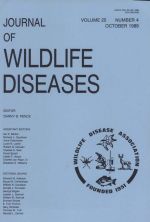Frog erythrocytic virus (FEV), one of the largest icosahedral viruses, is enveloped, measures up to 450 nm in diameter, and contains double stranded DNA. The virus is found in the cytoplasm of erythrocytes of Rana catesbeiana, Rana septentrionalis, and Rana clamitans from Algonquin Park, Ontario (Canada). Acidophilic inclusions in infected erythrocytes stained with Giemsas stain correspond to viroplasms from which FEV buds and forms aggregates of virus particles as seen in the electron microscope. Frog erythrocytic virus appears to acquire its envelope from lamellar membranes which surround the virus particles. The virus is structurally sensitive to cesium chloride, potassium tartrate and glycerol. It is also sensitive at pH 1 to 5 and a temperature of 56 C for 15 min. The virus contains at least 16 proteins which range in relative molecular mass from 19.5 to 91.0 kilodaltons (kDa), with two major proteins of 31.0 and 43.0 kDa. The viral DNA has a buoyant density of 1.690 ± 0.005 g/ml, guanine plus cytosine ratio of 25 to 36%, and a melting temperature of 82 to 86 C. Data from this study indicate that FEV should be included in the family Iridoviridae.
How to translate text using browser tools
1 October 1989
ULTRASTRUCTURAL, BIOCHEMICAL AND BIOPHYSICAL PROPERTIES OF AN ERYTHROCYTIC VIRUS OF FROGS FROM ONTARIO, CANADA
Jasmine Gruia-Gray,
Martin Petric,
Sherwin Desser

Journal of Wildlife Diseases
Vol. 25 • No. 4
October 1989
Vol. 25 • No. 4
October 1989
biochemical and biophysical properties
Characterization
frog erythrocytic virus
iridovirus
Rana spp.
ultrastructure




